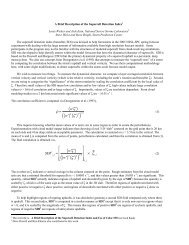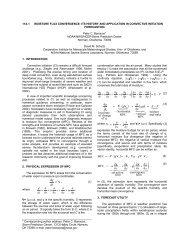On Issues of Tornado Damage Assessment and F-Scale Assignment
On Issues of Tornado Damage Assessment and F-Scale Assignment
On Issues of Tornado Damage Assessment and F-Scale Assignment
Create successful ePaper yourself
Turn your PDF publications into a flip-book with our unique Google optimized e-Paper software.
4.1 ON ISSUES OF TORNADO DAMAGE ASSESSMENT AND F-SCALE ASSIGNMENT<br />
IN AGRICULTURAL AREAS<br />
Jared L. Guyer <strong>and</strong> Michael L. Moritz<br />
NOAA/National Weather Service Hastings, Nebraska<br />
1. INTRODUCTION<br />
It is well established that the majority <strong>of</strong> the<br />
world’s tornadoes occur in "tornado alley" <strong>of</strong> the United<br />
States plains region. The plains is generally<br />
characterized by an agrarian based economy <strong>and</strong> a<br />
relatively low population density.<br />
While the plains region receives the bulk <strong>of</strong> the<br />
tornadoes in the United States, from a tornado<br />
climatology st<strong>and</strong>point, the tornadoes are <strong>of</strong> a lesser<br />
F-scale rating (Fujita 1971) on average than those <strong>of</strong> the<br />
higher populated areas <strong>of</strong> the eastern United States.<br />
This geographic discrepancy <strong>of</strong> F-scale climatology has<br />
been well documented in previous research literature<br />
(Kelly et al. 1978, Doswell <strong>and</strong> Burgess 1988, Grazulis<br />
1993). As these studies have noted, this is not<br />
necessarily attributed to a difference in tornado<br />
intensity, but instead, is an artifact <strong>of</strong> population bias<br />
<strong>and</strong> associated lack <strong>of</strong> structures.<br />
Doswell <strong>and</strong> Burgess (1988) discussed the<br />
reality <strong>of</strong> the F-scale as a damage scale versus an<br />
intensity scale. They noted tornadoes which occur in<br />
open country <strong>of</strong>tentimes do not damage structures,<br />
hence making an F-scale estimation more difficult.<br />
Schaefer <strong>and</strong> Galway (1982) noted a population bias in<br />
tornado climatology in the western plains from<br />
Oklahoma through Kansas to the Dakotas, finding that<br />
tornadoes that strike higher populated areas tend to<br />
have a higher rating than those that remain in open<br />
country.<br />
Furthermore, the number <strong>of</strong> structures in the<br />
plains will only continue to diminish as an everincreasing<br />
trend toward agribusinesses or exp<strong>and</strong>ed<br />
family farms results in a less “usable” tornado intensity<br />
detection grid (Grazulis 1993).<br />
Presently, F-scale definitions only provide<br />
vague guidance for damage assessment as “<strong>of</strong>ficial”<br />
documentation favors structural-based definitions.<br />
These aforementioned factors ultimately pose special<br />
challenges to a consistent operational assignment <strong>of</strong><br />
F-scale ratings to tornado damage in predominately<br />
agricultural areas.<br />
To compensate for the lack <strong>of</strong> structures in the<br />
plains region, it is theorized by the authors that<br />
exp<strong>and</strong>ed rating considerations should be formalized for<br />
the sake <strong>of</strong> climatological <strong>and</strong> historical consistency<br />
Corresponding author address: Jared L. Guyer,<br />
National Weather Service, 6365 Osborne Drive West,<br />
Hastings, NE 68901; e-mail: Jared.Guyer@noaa.gov<br />
regarding the F-scale. Potential incorporation or<br />
st<strong>and</strong>ardization <strong>of</strong> rating criteria that is native to the<br />
plains region, namely agricultural structures (e.g.,<br />
irrigation pivots) <strong>and</strong> crops in Nebraska in this instance,<br />
will be discussed as a potential basis for F-scale rating<br />
guidance.<br />
2. CENTER PIVOT IRRIGATION<br />
Due to a slightly drier climate, coupled with an<br />
abundance <strong>of</strong> underground water, Nebraska relies<br />
heavily on irrigation for crop production. There are two<br />
methods <strong>of</strong> irrigation, one being gravity or flood<br />
irrigation, <strong>and</strong> the other the use <strong>of</strong> center pivot irrigation<br />
systems. Center pivot systems are more efficient than<br />
the traditional gravity <strong>and</strong> flood irrigation methods. The<br />
four major center pivot irrigation system manufacturers<br />
are located in Nebraska <strong>and</strong> account for 90% <strong>of</strong> sales<br />
worldwide.<br />
Figure 1. Center pivot irrigation. Image courtesy United States<br />
Geological Survey (USGS).<br />
Over 42,000 center pivot irrigation systems are<br />
registered in Nebraska, with that number continuing a<br />
steady increase. Center pivot irrigation accounts for<br />
more than 4.6 million acres <strong>of</strong> cropl<strong>and</strong> in Nebraska,<br />
roughly 62% <strong>of</strong> the total irrigated cropl<strong>and</strong>. With<br />
irrigation pivots taking a more prevalent role over the<br />
last quarter <strong>of</strong> a century, the amount <strong>of</strong> irrigated<br />
cropl<strong>and</strong> has tripled during the past 25 years. It is<br />
estimated that as much as 70% <strong>of</strong> Nebraska’s irrigated
acreage could be under center pivot systems by 2010.<br />
(UNL Institute <strong>of</strong> Agriculture <strong>and</strong> Natural Resources,<br />
2001).<br />
Although design specifications vary between<br />
manufacturers, center irrigation pivots typically extend<br />
for 0.25 miles in length <strong>and</strong> consist <strong>of</strong> 6 to 11 spans.<br />
Generally made <strong>of</strong> galvanized steel, the total weight for<br />
each tower <strong>and</strong> span (void <strong>of</strong> water) may range from<br />
3500 to 5000 lbs. The average irrigation pivot is<br />
capable <strong>of</strong> moving more than a million gallons <strong>of</strong> water<br />
per day (T-L Irrigation, 2002).<br />
Consultation with irrigation pivot manufacturers<br />
(i.e. T-L Irrigation) indicates a general 80 mph design<br />
st<strong>and</strong>ard for resistance to overturning in high wind<br />
situations (void <strong>of</strong> water loading). Although specific<br />
criteria for typical wind resistance for water loaded<br />
pivots are sparse, the overall overturning threshold<br />
would be considerably higher.<br />
Aside from fundamental design specifications,<br />
several additional factors must be considered when<br />
assessing damage to irrigation pivots. For example: (1)<br />
the original orientation <strong>of</strong> the pivot (2) whether the pivot<br />
is designed to “rock” or “roll” – is a braking system<br />
employed by the pivot? <strong>and</strong> (3) proximity <strong>of</strong> the damage<br />
to the center <strong>of</strong> the pivot – i.e. better anchoring near the<br />
tower directly attached to the water source.<br />
Given the propensity <strong>of</strong> irrigation pivots in the<br />
plains region, it would seem appropriate for inclusion<br />
into F-scale definitions <strong>and</strong>/or st<strong>and</strong>ards. Additional<br />
information <strong>and</strong> guidance by wind <strong>and</strong> agricultural<br />
engineers would ultimately be necessary to refine<br />
potential applications to damage assessment<br />
techniques.<br />
3. CROPS<br />
According the United States Department <strong>of</strong><br />
Agriculture, nearly 76 million acres <strong>of</strong> corn were planted<br />
in the United States in 2001, <strong>of</strong> which 8 million acres<br />
were planted in Nebraska. In south central Nebraska,<br />
approximately 5 million acres <strong>of</strong> corn <strong>and</strong> soybeans<br />
were planted, representing around one-half <strong>of</strong> the total<br />
l<strong>and</strong> area.<br />
Fujita (1993) utilized crop damage in his review<br />
<strong>of</strong> the Plainfield, IL tornado <strong>of</strong> 28 August 1990. He<br />
appeared to place a high factor <strong>of</strong> reliability <strong>and</strong><br />
importance on the damage observed in the crops<br />
(namely corn, wheat, <strong>and</strong> beans). Fujita went as far as<br />
identifying “comma-shaped”, “swirl-shaped”, <strong>and</strong> “eyeshaped”<br />
patterns in the crops.<br />
Representative pictures encompassed the<br />
entire F0 to F5 gamut. In the case <strong>of</strong> the Plainfield<br />
tornado, damage was so intense, Fujita surmised an<br />
area <strong>of</strong> F5 winds based upon corn damage alone. In this<br />
case, the corn stalk was almost completely ripped from<br />
the ground. Fujita characterized the “corn crops were<br />
stripped <strong>of</strong> leaves <strong>and</strong> ears <strong>and</strong> pushed practically down<br />
to the ground. In the worst damaged area, corn crops<br />
were blown away entirely, leaving behind the remnants<br />
<strong>of</strong> small roots connected to the underground root<br />
system.”<br />
Figure 3. <strong>Tornado</strong> damage to a corn field. Photo by first<br />
author.<br />
Figure 2. Map <strong>of</strong> center pivot irrigation systems in Nebraska<br />
based upon 1997 data. Map courtesy <strong>of</strong> the Center for<br />
Advanced L<strong>and</strong> Management Information Technologies<br />
(CALMIT).<br />
In assessing F-scale damage in rural areas,<br />
notably corn fields, many conditions should be<br />
considered. Obviously the timing <strong>and</strong> velocity <strong>of</strong> the<br />
wind is important, but so is the stage <strong>of</strong> growth <strong>of</strong> the<br />
corn plant. The plant is most susceptible to breakage<br />
during rapid growth stages (approximately 2 to 3 feet<br />
high), which is usually in June. Historically, June<br />
corresponds to peak tornado activity in Nebraska. As<br />
the plant matures to the tasselling stage in July, the<br />
stalk will strengthen <strong>and</strong> may be able to withst<strong>and</strong><br />
stronger winds (Pioneer Hi-Bred International, 1999).
Different corn plants, or hybrids, are tested for<br />
stalk breakage. Brittle snap (also known as green snap)<br />
is a term which describes a corn plant stalk which has<br />
been broken by high winds. The brittle stalk score is a<br />
score which reflects artificial testing <strong>of</strong> a hybrid’s<br />
tendency <strong>and</strong> frequency for brittle stalk breakage. A<br />
score <strong>of</strong> 9 indicates the least risk <strong>of</strong> breakage <strong>and</strong> 1<br />
indicates the highest risk. A score <strong>of</strong> 9 does not<br />
guarantee resistance to brittle snap though. Other<br />
factors such as planting practices, fertilizing<br />
methodology, <strong>and</strong> soil conditions can also affect a<br />
plant’s susceptibility to damage caused by high winds or<br />
tornadoes (Pioneer Hi-Bred International, 1999).<br />
Too many factors (e.g., growing cycle, soil<br />
moisture variability, crop health) may be involved to<br />
reliably utilize crop damage as a sole source <strong>of</strong> an<br />
F-scale rating; nevertheless, there may be utility as a<br />
supplementary means <strong>of</strong> guidance.<br />
4. CONCLUDING REMARKS AND SUGGESTIONS<br />
For the sake <strong>of</strong> consistency in operational<br />
F-scale assignment amongst geographic regions, the<br />
authors suggest the F-scale incorporate additional nonstructural<br />
types <strong>of</strong> damage. The authors propose that<br />
F-scale definitions <strong>and</strong>/or guidelines be exp<strong>and</strong>ed to<br />
better incorporate those things native to rural <strong>and</strong><br />
agricultural settings.<br />
Specifically, it is suggested F-scale<br />
descriptions should be refined to incorporate such<br />
things as irrigation pivots, agricultural crops, <strong>and</strong> other<br />
types <strong>of</strong> vegetation. With more inclusive definitions, it is<br />
theorized that the discrepancy in F-scale climatology<br />
between rural <strong>and</strong> higher populated areas may at least<br />
be partially minimized.<br />
Furthermore, the authors encourage other<br />
National Weather Service (NWS) <strong>of</strong>fices to research<br />
local st<strong>and</strong>ards <strong>and</strong> specifications within their own area<br />
<strong>of</strong> responsibility. The authors recommend those who<br />
routinely conduct surveys in rural areas consider the<br />
unique nature <strong>of</strong> the structures <strong>and</strong> green cover in their<br />
areas. If relatively little background information is<br />
known about the structures (i.e. pivots) or green cover<br />
(crop maturity <strong>and</strong> hybrids), the authors suggest<br />
obtaining information from local producers <strong>and</strong><br />
manufacturers to provide more consistency in tornado<br />
damage assessment. Ultimately, the locally derived<br />
information should be shared for the purposes <strong>of</strong><br />
statewide <strong>and</strong> regional uniformity.<br />
5. ACKNOWLEDGEMENTS<br />
The authors would like to thank T-L Irrigation<br />
for their time <strong>and</strong> consultation on this project. The<br />
various reviewers <strong>of</strong> this manuscript are acknowledged<br />
for the constructive comments <strong>and</strong> valuable input.<br />
6. REFERENCES<br />
Doswell, C.A., III, <strong>and</strong> D.W. Burgess, 1988: Some<br />
issues <strong>of</strong> United States tornado climatology. Mon. Wea.<br />
Rev., 116, 495-501.<br />
Fujita, T.T., 1971: Proposed characterization <strong>of</strong><br />
tornadoes <strong>and</strong> hurricanes by area <strong>and</strong> intensity. SMRP<br />
Res. Paper 91, Univ. <strong>of</strong> Chicago, 42 pp.<br />
Fujita, T.T., 1993: Plainfield <strong>Tornado</strong> <strong>of</strong> August 28,<br />
1990. The <strong>Tornado</strong>: Its Structure, Dynamics,<br />
Prediction, <strong>and</strong> Hazards. Geophysical Monograph 79,<br />
1993. American Geophysical Union.<br />
Grazulis, T.P., 1993: A 100-Year Perspective <strong>of</strong><br />
Significant <strong>Tornado</strong>es. The <strong>Tornado</strong>: Its Structure,<br />
Dynamics, Prediction, <strong>and</strong> Hazards. Geophys. Monogr.<br />
79, Amer. Geophys. Union, 467-474.<br />
Grazulis, T.P., J.T. Schaefer, <strong>and</strong> R.F. Abbey Jr., 1993:<br />
Advances in tornado climatology, hazards, <strong>and</strong> risk<br />
assessment since tornado symposium II. The <strong>Tornado</strong>:<br />
Its Structure, Dynamics, Prediction, <strong>and</strong> Hazards.<br />
Geophys. Monogr. 79, Amer. Geophys. Union, 409-426.<br />
Institute <strong>of</strong> Agriculture <strong>and</strong> Natural Resources, 2001:<br />
Cornhusker Economics. Department <strong>of</strong> Agricultural<br />
Economics, University <strong>of</strong> Nebraska Lincoln.<br />
Kelly, D.L., J.T. Schaefer, R. P. McNulty, C.A. Doswell<br />
III <strong>and</strong> R.F. Abbey, Jr., 1978: An augmented tornado<br />
climatology. Mon. Wea. Rev., 106, 1172-1183.<br />
Pioneer Hi-Bred International, Inc., 1999: Crop Insights,<br />
Volume 9, Number 3.<br />
Schaefer, J.T., <strong>and</strong> J.G. Galway, 1982: Population<br />
biases in the tornado climatology. Preprints 12 th Conf.<br />
<strong>On</strong> Severe Local Storms, San Antonio, Amer. Meteor.<br />
Soc., 51-54.<br />
T-L Irrigation, 2002: Personal Communication.



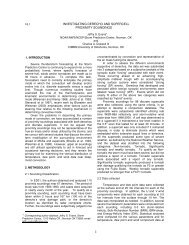
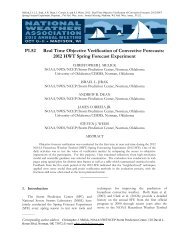
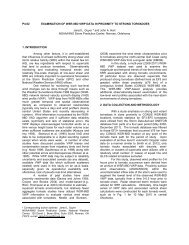
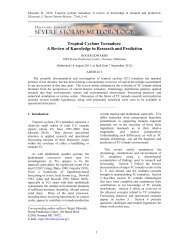


![NSWW_ROC_Overview.ppt [Read-Only] - Storm Prediction Center ...](https://img.yumpu.com/26478320/1/190x146/nsww-roc-overviewppt-read-only-storm-prediction-center-.jpg?quality=85)
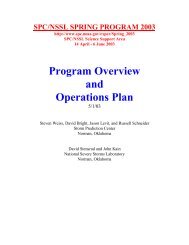
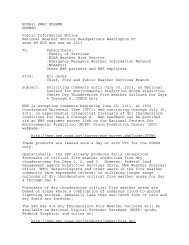
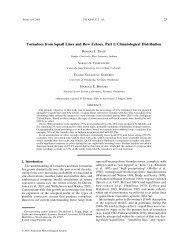

![NEW_PRODUCTS_imy.ppt [Read-Only] - Storm Prediction Center ...](https://img.yumpu.com/26478296/1/190x146/new-products-imyppt-read-only-storm-prediction-center-.jpg?quality=85)
